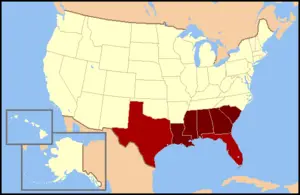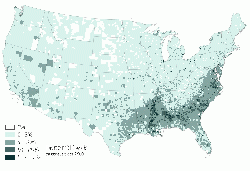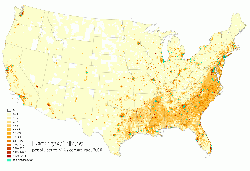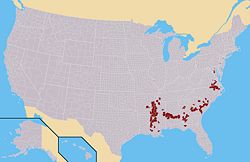Difference between revisions of "Deep South" - New World Encyclopedia
Mary Anglin (talk | contribs) m (→Population) |
Mary Anglin (talk | contribs) m |
||
| Line 26: | Line 26: | ||
==History== | ==History== | ||
| − | [[Image:New 2000 black percent.gif|thumb| | + | [[Image:New 2000 black percent.gif|thumb|250px|right|Blacks as percentage of local population, 2000.]][[Image:New 2000 black density.gif|thumb|250px|right|Black population density in the United States, 2000.]] |
The term ''Black Belt'' is still used to describe a crescent-shaped region about {{convert|300|mi|km}} long and up to {{convert|25|mi|km}} wide, extending from southwest [[Tennessee]] to east-central [[Mississippi]] and then east through Alabama to the border with Georgia. Before the nineteenth century, this region was a mosaic of [[prairie]]s and [[oak]]-[[hickory]] [[forest]]s.<ref>http://www.msstate.edu/org/mississippientmuseum/habitats/black.belt.prairie/BlackBeltPrairie.htm Black Belt Prairie]</ref> In the 1820s and 1830s, this region was identified as prime land for [[cotton]] plantations, resulting in a rush of immigrant planters and their [[Slavery|slaves]] called ''Alabama Fever''. The region became one of the cores of an expanding cotton plantation system that spread through much of the American South. Eventually, ''Black Belt'' came to describe the larger area of the South with historic ties to slave plantation agriculture and the cash [[crop]]s cotton, [[rice]], [[sugar]], and [[tobacco]]. | The term ''Black Belt'' is still used to describe a crescent-shaped region about {{convert|300|mi|km}} long and up to {{convert|25|mi|km}} wide, extending from southwest [[Tennessee]] to east-central [[Mississippi]] and then east through Alabama to the border with Georgia. Before the nineteenth century, this region was a mosaic of [[prairie]]s and [[oak]]-[[hickory]] [[forest]]s.<ref>http://www.msstate.edu/org/mississippientmuseum/habitats/black.belt.prairie/BlackBeltPrairie.htm Black Belt Prairie]</ref> In the 1820s and 1830s, this region was identified as prime land for [[cotton]] plantations, resulting in a rush of immigrant planters and their [[Slavery|slaves]] called ''Alabama Fever''. The region became one of the cores of an expanding cotton plantation system that spread through much of the American South. Eventually, ''Black Belt'' came to describe the larger area of the South with historic ties to slave plantation agriculture and the cash [[crop]]s cotton, [[rice]], [[sugar]], and [[tobacco]]. | ||
| Line 35: | Line 35: | ||
The [[African American]] push to be afforded civil rights equal to those of white Americans had roots in the center of the Deep South. Despite the successes of the [[civil rights movement]], the region remains one of the nation's poorest. Most of it remains rural, with a diverse range of crops, including most of the nation's [[peanut]] and [[soybean]] production. | The [[African American]] push to be afforded civil rights equal to those of white Americans had roots in the center of the Deep South. Despite the successes of the [[civil rights movement]], the region remains one of the nation's poorest. Most of it remains rural, with a diverse range of crops, including most of the nation's [[peanut]] and [[soybean]] production. | ||
| − | [[Image:Majority Black Counties.JPG|right|thumb| | + | [[Image:Majority Black Counties.JPG|right|thumb|250px|Counties in the United States where [[Black people|blacks]] are the majority of the population.]] |
In his 1901 autobiography ''Up from Slavery'', [[Booker T. Washington]] wrote, describing the Black Belt, | In his 1901 autobiography ''Up from Slavery'', [[Booker T. Washington]] wrote, describing the Black Belt, | ||
| Line 51: | Line 51: | ||
The "Old South" is usually defined in opposition to the Deep South including [[Alabama]], [[Louisiana]], [[Georgia (U.S. state)|Georgia]] and [[Mississippi]], and it is also further differentiated from the inland [[Border states (Civil War)|border states]] such as [[Kentucky]] and [[West Virginia]] and the peripheral southern states of [[Florida]] and [[Texas]]. | The "Old South" is usually defined in opposition to the Deep South including [[Alabama]], [[Louisiana]], [[Georgia (U.S. state)|Georgia]] and [[Mississippi]], and it is also further differentiated from the inland [[Border states (Civil War)|border states]] such as [[Kentucky]] and [[West Virginia]] and the peripheral southern states of [[Florida]] and [[Texas]]. | ||
| + | |||
==Looking to the future== | ==Looking to the future== | ||
The former agricultural economy of the region is being replaced. [[Louisiana]]'s industries include chemical products, petroleum and coal products, food processing and transportation equipment, and paper products. The Port of South Louisiana, located on the [[Mississippi River]] between [[New Orleans]] and Baton Rouge, is the largest-volume shipping port in the Western Hemisphere and fourth largest in the world. [[Tourism]] and culture are major players in Louisiana's economy. Alabama transitioned from agriculture to diversified interests in heavy manufacturing, [[mining]], education, and high technology. Alabama may even come to surpass [[Michigan]] as the largest [[automobile]] manufacturer in [[North America]]. [[Georgia]] has emerged as a regional leader, due in large part to Atlanta's rapid economic and population growth. | The former agricultural economy of the region is being replaced. [[Louisiana]]'s industries include chemical products, petroleum and coal products, food processing and transportation equipment, and paper products. The Port of South Louisiana, located on the [[Mississippi River]] between [[New Orleans]] and Baton Rouge, is the largest-volume shipping port in the Western Hemisphere and fourth largest in the world. [[Tourism]] and culture are major players in Louisiana's economy. Alabama transitioned from agriculture to diversified interests in heavy manufacturing, [[mining]], education, and high technology. Alabama may even come to surpass [[Michigan]] as the largest [[automobile]] manufacturer in [[North America]]. [[Georgia]] has emerged as a regional leader, due in large part to Atlanta's rapid economic and population growth. | ||
Revision as of 04:05, 30 October 2008
The Deep South is a descriptive category of cultural and geographic subregions in the American South. Historically, it is differentiated from the "Upper South" as being the states that were most dependent on plantation-type agriculture during the period before the Civil War. The Deep South was also commonly referred to as the Lower South or the "Cotton States."
Today, the Deep South is usually delineated as being those states and areas where things most often thought of as "Southern" exist in their most concentrated form.[1]
The Deep South is distinguished from the Old South in that the "Old South" states are those that were among the original thirteen American colonies. Another frequently used term is Black Belt, which Booker T. Washington described as "the part of the South ... where the black people outnumber the white."
Usage of the term
The term "Deep South" is defined in a variety of ways:
- Most definitions include the states of Alabama, Georgia, Louisiana, Mississippi, and South Carolina.[2][3]
- The seven states that seceded from the United States before the firing on Fort Sumter and the start of the American Civil War, and originally formed the Confederate States of America. In order of secession they are: South Carolina, Mississippi, Florida, Alabama, Georgia, Louisiana, and Texas.
Due to the migration patterns of the last half-century, large areas of Florida and Texas are often no longer included. However, there are certain parts of these states, such as East Texas and the Florida Panhandle, that retain cultural characteristics of the Deep South.[4]
Politics
For most of the nineteenth and twentieth centuries, the Deep South overwhelmingly supported the Democratic Party, viewing the rival Republican Party as a Northern organization responsible for the Civil War, which devastated the economy of the Old South. This pattern became known as the "Solid South." Since the 1964 presidential election, however,[5] along with the Civil Rights Movement, the Deep South has tended to vote for the Republican candidate in presidential elections, except in the 1976 election when Georgia native Jimmy Carter received the Democratic nomination. Since the 1990s there has been a continued shift toward Republican candidates in most political venues; another Georgian, Republican Newt Gingrich, was elected U.S. Speaker of the House in 1995.
Presidential elections in which the region diverged noticeably from the Upper South occurred in 1928, 1948, 1964 and 1968, and, to a lesser extent, in 1952 and 1956.
Population
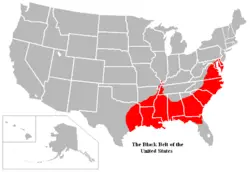
Within the Deep South is a region known as the Black Belt. Although the term originally described the prairies and dark soil of central Alabama and northeast Mississippi, it long has been used for a broad region in the South characterized by a high percentage of black people, acute poverty, rural decline, inadequate education programs, low educational attainment, poor health care, substandard housing, and high levels of crime and unemployment. While black residents are disproportionately affected, these problems apply to the region's general population. There are various definitions of the region, but it is generally a belt-like band through the center of the Deep South, stretching as far west as eastern Texas.
History
The term Black Belt is still used to describe a crescent-shaped region about 300 miles (480 km) long and up to 25 miles (40 km) wide, extending from southwest Tennessee to east-central Mississippi and then east through Alabama to the border with Georgia. Before the nineteenth century, this region was a mosaic of prairies and oak-hickory forests.[6] In the 1820s and 1830s, this region was identified as prime land for cotton plantations, resulting in a rush of immigrant planters and their slaves called Alabama Fever. The region became one of the cores of an expanding cotton plantation system that spread through much of the American South. Eventually, Black Belt came to describe the larger area of the South with historic ties to slave plantation agriculture and the cash crops cotton, rice, sugar, and tobacco.
After the Civil War, slave-based plantations were generally replaced by a system of sharecropping.
Although this had been a richly productive region, the early twentieth century brought a general economic collapse, among the many causes of which were soil erosion and depletion, the boll weevil invasion and subsequent collapse of the cotton economy, and the socially repressive Jim Crow laws. What had been one of the nation's wealthiest and most politically powerful regions became one of the poorest.
The African American push to be afforded civil rights equal to those of white Americans had roots in the center of the Deep South. Despite the successes of the civil rights movement, the region remains one of the nation's poorest. Most of it remains rural, with a diverse range of crops, including most of the nation's peanut and soybean production.
In his 1901 autobiography Up from Slavery, Booker T. Washington wrote, describing the Black Belt,
The term was first used to designate a part of the country which was distinguished by the colour of the soil. The part of the country possessing this thick, dark, and naturally rich soil was, of course, the part of the South where the slaves were most profitable, and consequently they were taken there in the largest numbers. Later and especially since the [civil] war, the term seems to be used wholly in a political sense—that is, to designate the counties where the black people outnumber the white.
There are 96 counties where the black percentage of the population is over 50 percent, of which 95 are distributed across the Coastal and Lowland South in a loose arc.[7]
In 2000, a United States Department of Agriculture report proposed creating a federal regional commission, similar to the Appalachian Regional Commission, to address the social and economic problems of the Black Belt. This politically defined region, called the Southern Black Belt, is a patchwork of 623 counties scattered throughout the South.[8][9]
Old South
Geographically, Old South is a subregion of the American South, differentiated from the "Deep South" as being the Southern states represented in the original thirteen American colonies, as well as a way of describing the former lifestyle in the Southern United States. Culturally, the term can be used to describe the antebellum period.
Geographic usage
The Southern colonies were Virginia, Maryland, North Carolina, Delaware, South Carolina, and Georgia. Despite Maryland's early association as a Southern colony and later as a state, based on customs, economy, and slave ownership, its failure to secede during the American Civil War has resulted in a modern disassociation with the area known as the "Old South," a disassociation even more pronounced in the similar case of Delaware.
The "Old South" is usually defined in opposition to the Deep South including Alabama, Louisiana, Georgia and Mississippi, and it is also further differentiated from the inland border states such as Kentucky and West Virginia and the peripheral southern states of Florida and Texas.
Looking to the future
The former agricultural economy of the region is being replaced. Louisiana's industries include chemical products, petroleum and coal products, food processing and transportation equipment, and paper products. The Port of South Louisiana, located on the Mississippi River between New Orleans and Baton Rouge, is the largest-volume shipping port in the Western Hemisphere and fourth largest in the world. Tourism and culture are major players in Louisiana's economy. Alabama transitioned from agriculture to diversified interests in heavy manufacturing, mining, education, and high technology. Alabama may even come to surpass Michigan as the largest automobile manufacturer in North America. Georgia has emerged as a regional leader, due in large part to Atlanta's rapid economic and population growth.
Before Hurricane Katrina struck the Gulf Coast, Mississippi was the second largest gambling state in the Union, after Nevada and ahead of New Jersey, seeking to capitalize on its climate to offset rural poverty that still prevails. A 2007 government report found that Mississippi was the poorest state in the country. Many white cotton farmers have large, mechanized plantations, some of which receive extensive federal subsidies, yet many African Americans still live as poor, rural, landless laborers.
Farms have become fewer but larger in recent years. South Carolina ranks third in peach production; it ranks fourth in overall tobacco production. Other top agricultural commodities include nursery and greenhouse products, watermelons, [[peanut]s, broilers and turkeys.
While South Carolina is still a major agricultural producer, its industrial outputs include textile goods, chemical products, paper products, and machinery. Some 25 percent of manufacturing companies in South Carolina are foreign-owned. In 2003 trade pumped $23 billion into the state economy and generated $2.5 billion in state and local taxes.
Notes
- ↑ "1001 Things Everyone Should Know About the South". John Reed and Dale Volberg Reed. Doubleday 1996
- ↑ TheFreeDictionary. Deep South Retrieved October 30, 2008.
- ↑ Synonym.com. Deep South Retrieved October 30, 2008.
- ↑ Reed, John Shelton, and Dale Volberg Reed. 1996. 1001 things everyone should know about the South. New York: Doubleday. ISBN 9780385474412
- ↑ For many Southern white voters, Republican Dwight D. Eisenhower first broke their voting behavior in the presidential elections of 1952 and 1956, but with the Goldwater-Johnson election of 1964 a significant contingent of those same voters crossed the Rubicon into more or less permanent adherence to the Republican Party. Correspondingly, support for Republicans among black voters continued eroding, as it had started moving toward Democrats in the Franklin Delano Roosevelt election of 1936.
- ↑ http://www.msstate.edu/org/mississippientmuseum/habitats/black.belt.prairie/BlackBeltPrairie.htm Black Belt Prairie]
- ↑ http://www.census.gov/prod/2001pubs/c2kbr01-5.pdf The Black Population: Census 2000 Brief
- ↑ The Southern Black Belt
- ↑ http://www.ers.usda.gov/publications/ruralamerica/ra151/ra151d.pdf Federal Funds for the Black Belt
ReferencesISBN links support NWE through referral fees
- Atkins, Leah Rawls, Wayne Flynt, William Warren Rogers, and David Ward. 1994. Alabama: The History of a Deep South State. ISBN 9780585263670
- Johnson, Walter. 1999. Soul by Soul: Life Inside the Antebellum Slave Market. Cambridge, MA: Harvard University Press. ISBN 0674821483
- Peirce, Neal R. 1974. The Deep South States of America; people, politics, and power in the seven Deep South States. New York: Norton. ISBN 9780393054965
- Winstead, Mary. 2002. Back to Mississippi: A Personal Journey Through the Events that Changed America in 1964. New York: Hyperion. ISBN 0786867965
Credits
New World Encyclopedia writers and editors rewrote and completed the Wikipedia article in accordance with New World Encyclopedia standards. This article abides by terms of the Creative Commons CC-by-sa 3.0 License (CC-by-sa), which may be used and disseminated with proper attribution. Credit is due under the terms of this license that can reference both the New World Encyclopedia contributors and the selfless volunteer contributors of the Wikimedia Foundation. To cite this article click here for a list of acceptable citing formats.The history of earlier contributions by wikipedians is accessible to researchers here:
The history of this article since it was imported to New World Encyclopedia:
Note: Some restrictions may apply to use of individual images which are separately licensed.
